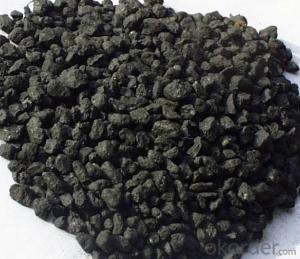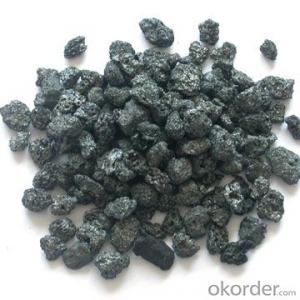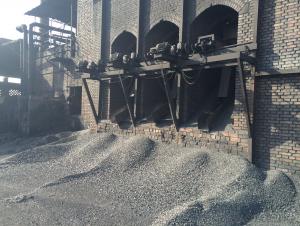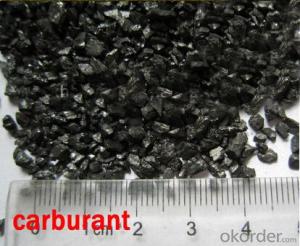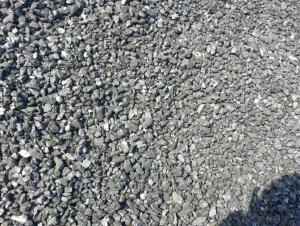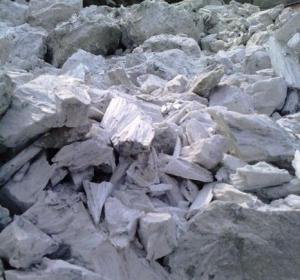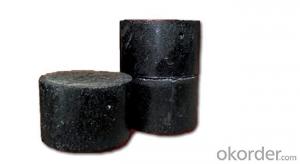CPC Low Sulfur Petroleum Coke FC 98.5% Cheap Price
- Loading Port:
- Tianjin
- Payment Terms:
- TT or LC
- Min Order Qty:
- 20 m.t.
- Supply Capability:
- 3000 m.t./month
OKorder Service Pledge
OKorder Financial Service
You Might Also Like
Packaging & Delivery
| Packaging Detail: | 50kg/bag 100kg/bag 1000kg/bag Or according with client need |
| Delivery Detail: | 2 weeks |
Specifications
CPC Low Sulfur Petroleum Coke FC 98.5% Cheap Price
Petroleum coke products can be divided into needle coke, sponge coke, projectile coke and coke breeze four kinds.
Calcined Petroleum Coke
F.C.: 98.5%MIN
ASH: 0.8% MAX
V.M.: 0.7%MAX
S:0.5%MAX
Moisture: 0.5%MAX
Structure
CPC Low Sulfur Petroleum Coke FC 98.5% Cheap Price
Shape: granule
Dimensions: 0-1mm, 1-5mm, 1-6mm, 2-8mm, etc
Product Type: Carbon Additive
C Content (%): 98-99.5% MIN
Working Temperature: -
S Content (%): 0.5%-0.7%MAX
Ash Content (%): 0.7%MAX
Volatile:0.8%MAX
Moisture: 0.5% MAX
ADVANTAGE: low ash & sulfur
COLOR: Black
Feature
CPC Low Sulfur Petroleum Coke FC 98.5% Cheap Price
Physics and chemistry performance :
Unit | Index | |||||
No.1 | No.2 | No.3 | ||||
Density | g/cm3 | 2.04 | 2.00 | 2.00 | ||
sulphur content | %≤ | 0.5 | 1.0 | 2.5 | ||
volatility | %≤ | 0.5 | 0.5 | 0.5 | ||
ash content | %≤ | 0.5 | 0.5 | 0.5 | ||
moisture | %≤ | 0.3 | 0.5 | 0.5 | ||
charcoal | %≤ | 98.5 | 98.0 | 98.0 | ||
Image
CPC Low Sulfur Petroleum Coke FC 98.5% Cheap Price
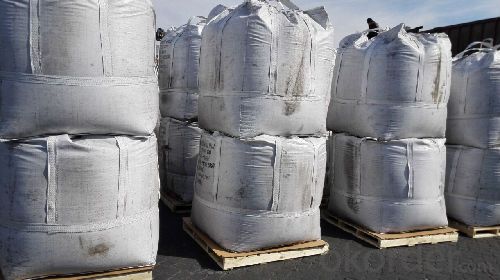
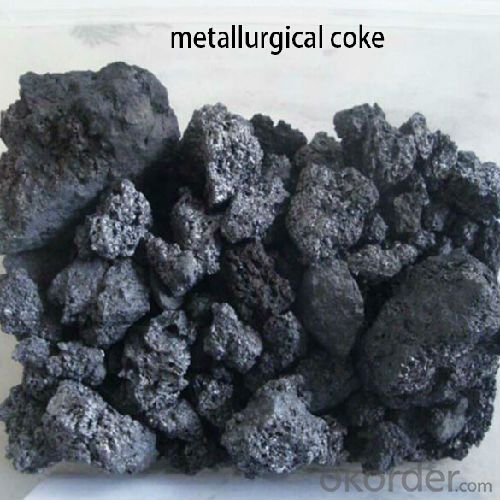
FAQ:
CPC Low Sulfur Petroleum Coke FC 98.5% Cheap Price
How to classify calcined petroleum coke?
1) According to difference of sulfur content, can be divided into high sulfur coke (sulfur content more than 4%), sulphur in coke sulfur content (2% 4%) and low sulfur coke (sulfur content below 2%).
2) Petroleum coke products can be divided into needle coke, sponge coke, projectile coke and coke breeze four kinds:
3) Needle coke, has obvious needle-like structure and fiber texture, mainly used for steel-making in high power and ultra-high power graphite electrode. As a result of needle coke in sulfur content, ash content, volatile matter and true density and so on have strict quality requirements, so the production process of needle coke and raw materials have special requirements.
4) The sponge coke, high chemical reactivity, low content of impurities, mainly used in the aluminum industry and carbon industry.
5) Focal or spherical coke: the projectile shape is round, diameter 0.6-30 mm, usually from the production of high sulphur, high asphaltic residual oil, can only be used as industrial fuel power generation, cement etc.
6) Coke breeze: fluidized coking process, the fine particles (0.1- 0.4 mm) in diameter, high volatile, high expansion coefficient, cannot be directly used for electrode preparation and carbon industry.
Advantage:
CPC Low Sulfur Petroleum Coke FC 98.5% Cheap Price
1. High quality and competitive price.
2. Timely delivery.
3. If any item you like. Please contact us.
Your sincere inquiries are typically answered within 24 hours.
- Q:What is carbon nanocomposite?
- Carbon nanocomposite refers to a type of material that combines carbon nanotubes or graphene with a matrix material, such as polymers or metals, to form a composite material. The carbon nanotubes or graphene are typically added in small amounts, often in the form of nanoparticles, to enhance the mechanical, electrical, and thermal properties of the composite material. Carbon nanotubes are cylindrical structures made up of carbon atoms arranged in a hexagonal lattice, while graphene is a single layer of carbon atoms arranged in a two-dimensional lattice. These carbon-based materials possess exceptional properties, such as high strength, electrical conductivity, and thermal conductivity. When incorporated into a composite material, these properties can be transferred to the overall structure, resulting in improved performance. The use of carbon nanocomposites has been explored in various industries and applications. In aerospace, for example, these materials have been investigated for their lightweight and high-strength properties, which could potentially enhance the fuel efficiency and durability of aircraft components. In electronics, carbon nanocomposites have shown promise for developing high-performance sensors, conductive films, and energy storage devices. Additionally, they have been studied for their potential applications in medical devices, automotive parts, and energy storage systems. Overall, carbon nanocomposites offer the opportunity to create materials with enhanced properties by leveraging the unique characteristics of carbon nanotubes or graphene. However, the production and scalability of these materials still pose challenges, and further research is needed to optimize their performance and cost-effectiveness for various applications.
- Q:What materials can be carbonitriding?
- Low temperature carbonitriding for high alloy tool steel, high-speed steel tools, etc., in temperature carbonitriding is under great pressure not only in carbon steel wear parts, high temperature carbonitriding is mainly used for medium carbon steel and alloy steel under great pressure.
- Q:How does carbon dioxide affect the acidity of rainwater?
- Carbon dioxide affects the acidity of rainwater by contributing to the formation of carbonic acid. When carbon dioxide dissolves in rainwater, it reacts with water molecules to form carbonic acid. This reaction increases the concentration of hydrogen ions (H+) in the water, leading to a decrease in pH and the formation of acidic rainwater. The carbonic acid formed from carbon dioxide is a weak acid, but it can still lower the pH of rainwater, making it more acidic than normal. This increased acidity can have detrimental effects on the environment, including damaging plant and animal life, corroding buildings and infrastructure, and affecting aquatic ecosystems.
- Q:when to use hard carbon, and when to use soft carbon. Neutral charcoal can play what role? Thank you.
- Soft charcoal as easily broken, so soft to the name. Hard charcoal is not easy to break, of course, also called hard charcoal. Models are generally marked with charcoal, it is easy to distinguish. When used, you can also judge.
- Q:What are the sources of carbon emissions?
- Human activities, particularly the burning of fossil fuels like coal, oil, and natural gas, are the primary cause of carbon emissions. The largest contributor to carbon emissions is the utilization of fossil fuels for generating electricity, transportation, and various industrial processes. Power plants that utilize coal and natural gas play a significant role in emitting carbon, as do vehicles that run on gasoline and diesel. Besides, carbon emissions also result from industrial processes, mainly in sectors like cement production and steel manufacturing. These processes release carbon dioxide (CO2) during the chemical reactions involved in producing these materials. Deforestation and changes in land use are another significant source of carbon emissions. When forests are cleared, the carbon stored in trees is released into the atmosphere as CO2. Moreover, the loss of forests reduces the Earth's capacity to absorb CO2 through photosynthesis, worsening the situation. Agricultural activities, particularly livestock farming, contribute to carbon emissions through the release of methane (CH4) from animals' digestive systems and the decay of organic matter. The use of synthetic fertilizers in agriculture further adds to carbon emissions as they release nitrous oxide (N2O), a potent greenhouse gas. Other sources of carbon emissions include waste management practices, particularly the decomposition of organic waste in landfills, and specific industrial processes that release other greenhouse gases like hydrofluorocarbons (HFCs) and sulfur hexafluoride (SF6). It is crucial to note that although natural processes like volcanic eruptions and wildfires also release carbon dioxide into the atmosphere, their contribution is significantly smaller compared to human-induced emissions.
- Q:What is carbon nanowire?
- Carbon nanowires are one-dimensional structures made entirely of carbon atoms. They are incredibly thin, with diameters ranging from a few nanometers to a few micrometers, while their length can vary from a few micrometers to several centimeters. These nanowires possess exceptional electrical, thermal, and mechanical properties due to their unique structure and composition. Carbon nanowires can be produced through various methods, such as chemical vapor deposition, electrospinning, or template synthesis. They can have different structures, including single-walled or multi-walled, and can be straight or coiled. The properties of carbon nanowires can be further enhanced by incorporating other elements or functional groups into their structure. One of the most significant advantages of carbon nanowires is their high electrical conductivity, which makes them suitable for various electronic and energy applications. They can be used as interconnects in nanoscale devices, electrodes in energy storage devices like batteries and supercapacitors, and in sensors for detecting various substances due to their exceptional sensitivity. Carbon nanowires also exhibit exceptional mechanical properties, such as high tensile strength and flexibility. These properties make them suitable for applications in nanotechnology, including reinforcement in composite materials, nanoscale actuators, or as templates for fabricating other nanoscale structures. Furthermore, carbon nanowires possess excellent thermal conductivity, which makes them potential candidates for thermal management applications, such as heat sinks or as fillers in thermal interface materials. In summary, carbon nanowires are ultrathin carbon-based structures with remarkable electrical, thermal, and mechanical properties. Their unique characteristics make them promising materials for a wide range of applications in electronics, energy, sensing, nanotechnology, and thermal management.
- Q:How does carbon affect the color of gemstones?
- Carbon can have a significant impact on the color of gemstones. In fact, it is one of the main factors that contribute to the coloration of certain gemstones. One of the most well-known examples is diamonds. Diamonds are made up of carbon atoms arranged in a crystal lattice structure. The presence of impurities or defects within this crystal lattice can cause the diamond to exhibit various colors. When there is a high concentration of carbon impurities in a diamond, it can result in a yellow or brown tint. These are known as "fancy colored diamonds" and are graded on a scale that ranges from D (colorless) to Z (light yellow or brown). The more carbon impurities present, the more intense the color becomes. On the other hand, a diamond with a lower concentration of carbon impurities will appear more colorless. Carbon can also affect the color of other gemstones. For example, certain varieties of sapphires can contain traces of carbon that give them a grayish or blackish appearance. These are known as "black sapphires" or "star sapphires" and are highly sought after for their unique coloration. Similarly, carbon impurities in rubies can cause them to have a purplish hue. It is important to note that while carbon can impact the color of gemstones, it is not the only factor that determines their color. Other elements or impurities, as well as the crystal structure and light absorption properties of the gemstone, also play a significant role. Overall, the presence of carbon in gemstones can result in a wide range of colors, adding to their beauty and desirability in the world of gemology.
- Q:other parameters are figured out, the difference is only in the carbon and carbon is not very clear, just know that they are winding mode is the opposite, there are two kinds of most printers can be used, what is the difference between the performance of them? Two can use the printer in the selection of the best carbon or carbon? Why? Please cite several models as an example.Please answer in your own words. Don't factor,
- In fact, to teach you a simple way to distinguish between internal and external carbon, carbon, label paper dip ribbon, with black on the outside of the outer side is carbon, carbon is in inside, no performance difference, now generally used is the most carbon, such as the machine is to use carbon is better, because the wound is not the same, sometimes loose.SATO machine with carbon is better, and the CITIZEN printer inside and outside carbon can be used, in addition to machine limitations, not what the difference is too big, the quality of internal and external carbon ribbon is the same.
- Q:Does anyone know what the definition of carbon storage is in ecology? Thank you
- If there is no clear definition of books on carbon storage in the understanding of ecology of the individual usually refers to the separation of gaseous carbon dioxide from the atmosphere, through the process of ecology carbon fixed, this process mainly refers to the plants convert carbon dioxide into carbohydrates.In addition, there is now another implication: carbon stripping technology will be used to collect carbon dioxide from human emissions into the air separation of the ground floor storage.
- Q:How is carbon used in the production of carbon nanowires?
- Carbon is a key component in the production of carbon nanowires due to its unique properties. Carbon nanowires are typically created through a process called chemical vapor deposition (CVD), which involves the decomposition of a carbon-containing precursor gas in a high-temperature environment. In this process, a carbon source, such as methane or ethylene, is introduced into a reaction chamber. The precursor gas is then heated to a high temperature, typically above 600 degrees Celsius, which causes it to decompose. As a result, carbon atoms are released and start to deposit on a substrate material, such as a silicon wafer or a metal catalyst. The carbon atoms in the precursor gas have a tendency to form strong covalent bonds with each other, leading to the formation of a graphite-like structure. However, by carefully controlling the growth conditions, such as temperature and pressure, the deposited carbon atoms can be made to arrange themselves in a highly ordered manner, forming nanowires. The use of carbon as the building block for nanowires is advantageous due to its exceptional thermal and electrical conductivity, as well as its high mechanical strength. This allows carbon nanowires to exhibit unique properties, making them suitable for various applications, such as in electronics, energy storage, and sensors. Overall, carbon plays a crucial role in the production of carbon nanowires by serving as the raw material that undergoes decomposition and subsequent rearrangement to form the desired nanoscale structures.
1. Manufacturer Overview |
|
|---|---|
| Location | |
| Year Established | |
| Annual Output Value | |
| Main Markets | |
| Company Certifications | |
2. Manufacturer Certificates |
|
|---|---|
| a) Certification Name | |
| Range | |
| Reference | |
| Validity Period | |
3. Manufacturer Capability |
|
|---|---|
| a)Trade Capacity | |
| Nearest Port | |
| Export Percentage | |
| No.of Employees in Trade Department | |
| Language Spoken: | |
| b)Factory Information | |
| Factory Size: | |
| No. of Production Lines | |
| Contract Manufacturing | |
| Product Price Range | |
Send your message to us
CPC Low Sulfur Petroleum Coke FC 98.5% Cheap Price
- Loading Port:
- Tianjin
- Payment Terms:
- TT or LC
- Min Order Qty:
- 20 m.t.
- Supply Capability:
- 3000 m.t./month
OKorder Service Pledge
OKorder Financial Service
Similar products
New products
Hot products
Hot Searches
Related keywords
